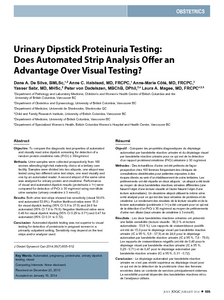De Silva, DA; Halstead, AC; Côté, AM; Sabr, Y; von Dadelszen, P; Magee, LA
(2014)
Urinary dipstick proteinuria testing: does automated strip analysis offer an advantage over visual testing?
Journal of Obstetrics and Gynaecology Canada, 36 (7).
pp. 605-612.
ISSN 1701-2163
https://doi.org/10.1016/S1701-2163(15)30540-5
SGUL Authors: von Dadelszen, Peter
![[img]](https://openaccess.sgul.ac.uk/107518/1.hassmallThumbnailVersion/de%20silva%20-%20jogc%20-%20visual%20vs%20dipstick%20-%202014.pdf)  Preview |
|
PDF
Published Version
Available under License ["licenses_description_publisher" not defined].
Download (420kB)
| Preview
|
Abstract
OBJECTIVE: To compare the diagnostic test properties of automated and visually read urine dipstick screening for detection of a random protein:creatinine ratio (PrCr) ≥ 30 mg/mmol. METHODS: Urine samples were collected prospectively from 160 women attending high-risk maternity clinics at a tertiary care facility. Samples were divided into two aliquots; one aliquot was tested using two different urine test strips, one read visually and one by an automated reader. A second aliquot of the same urine was analyzed for urinary protein and creatinine. Performance of visual and automated dipstick results (proteinuria ≥ 1+) were compared for detection of PrCr ≥ 30 mg/mmol using non-dilute urine samples (urinary creatinine ≥ 3 mmol/L). RESULTS: Both urine test strips showed low sensitivity (visual 56.0% and automated 53.8%). Positive likelihood ratios were 15.0 for visual dipstick testing (95% CI 5.9 to 37.9) and 24.6 for automated (95% CI 7.6 to 79.6). Negative likelihood ratios were 0.46 for visual dipstick testing (95% CI 0.29 to 0.71) and 0.47 for automated (95% CI 0.31 to 0.72). CONCLUSION: Automated dipstick testing was not superior to visual testing for detection of proteinuria in pregnant women in a primarily outpatient setting. Sensitivity may depend on the test strips and/or analyzer used.
| Item Type: |
Article
|
| Additional Information: |
© 2014 Society of Obstetricians and Gynaecologists of Canada. Published by Elsevier Inc. All rights reserved. Made available with permission from the publisher. Contact publisher for any further re-use. |
| Keywords: |
automated, pregnancy, proteinuria, urinary dipstick testing, visual, Adult, Automation, Creatinine, Female, Humans, Pregnancy, Pregnancy Complications, Prospective Studies, Proteinuria, Urinalysis, Humans, Proteinuria, Pregnancy Complications, Creatinine, Urinalysis, Prospective Studies, Pregnancy, Automation, Adult, Female, 1114 Paediatrics And Reproductive Medicine |
| SGUL Research Institute / Research Centre: |
Academic Structure > Molecular and Clinical Sciences Research Institute (MCS) |
| Journal or Publication Title: |
Journal of Obstetrics and Gynaecology Canada |
| ISSN: |
1701-2163 |
| Language: |
eng |
| Dates: |
| Date | Event |
|---|
| 1 July 2014 | Published |
|
| PubMed ID: |
25184979 |
 |
Go to PubMed abstract |
| URI: |
https://openaccess.sgul.ac.uk/id/eprint/107518 |
| Publisher's version: |
https://doi.org/10.1016/S1701-2163(15)30540-5 |
Statistics
Item downloaded times since 05 May 2016.
Actions (login required)
 |
Edit Item |



